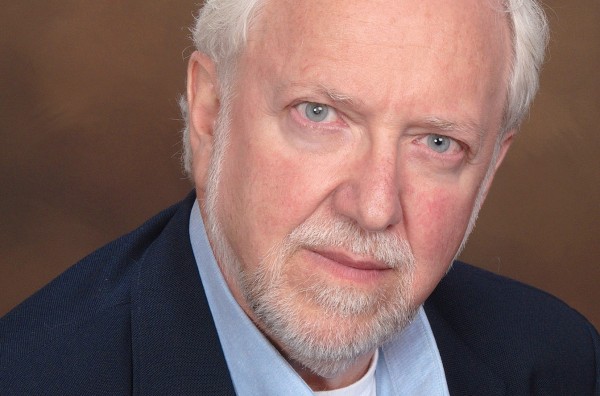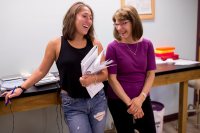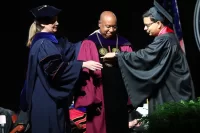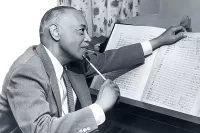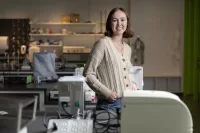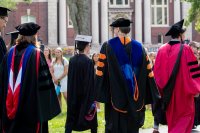
Tributes to retiring faculty of 2013: Baker, Hayward, Kuritz, Shulman, Thomas
At the final faculty meeting of the academic year, each retiring professor is honored by a colleague who prepares and delivers a spoken tribute.
On May 6, tributes were offered to Pam Baker ’69, the Helen A. Papaioanou Professor of Biological Sciences and, from 2011 to 2013, dean of the faculty; Tom Hayward, lecturer in classical and medieval studies and humanities reference librarian; Paul Kuritz, professor of theater; Bonnie Shulman, professor of mathematics; and Bob Thomas, professor of biology.
Tribute to Pam Baker by Don Dearborn, professor of biology
Pam Baker is an institutional thinker, a kind and smart person, and someone who loves this college with her entire being.
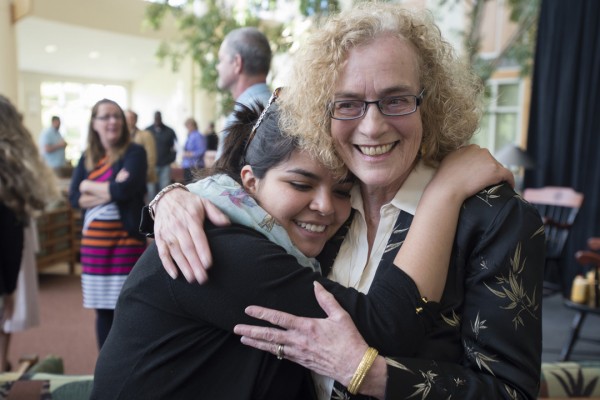
Pam Baker hugs a student during a reception for Baker’s retirement on May 17. (Mike Bradley/Bates College)
She came to Bates in 1965. Not as a faculty member, of course, but as a first-year student. Consistent with the wanderlust that would fuel her later travels, she left Bates prematurely, taking a B.Sc. in zoology at the University of Wales at Swansea before coming back here to finish her Bates degree in 1970. She went on to do graduate work at SUNY–Buffalo, with a master’s degree in microbiology and later a Ph.D. in oral biology and immunology.
Along the way, she and Dave were graced with their daughter, Kate, whom they soon learned was deaf. I mention this because Pam wanted to learn sign language with Kate but couldn’t find a book that a parent could share with a young child. In typical Pam fashion, she took the bull by the horns and wrote and published such a book herself while in graduate school.
Pam came back to Bates in 1989, hired with Lee Abrahamsen to share a tenure-track position. When I interviewed here just a few years ago, Pam and Lee were still sharing both a faculty line and an office. (As an aside, I’ll say that somehow I misread the situation, and my interest in Bates was heightened by the notion that the college was making joint hires of same-sex couples 20 years ago.)
My confusion notwithstanding, Pam and Lee were a formidable team in the classroom. They co-taught Cell Hell in Short Term for something like 18 years, and they were the first faculty from anywhere to teach a research-based course at Mount Desert Island Biological Laboratory, a first-rate research institution focused on regenerative medicine, environmental health sciences, and cellular and molecular physiology.
This partnership between Bates and MDIBL has thrived under Pam’s guidance and remains important to both our institutions.
For non-science folks, this next point may be a hard one to appreciate, so let me preface it by saying that it’s a big deal.
Pam’s own research combines the study of bacteria, the immune system and the dynamics of infectious disease, along with her an interest in non-Western medicine. Pam has co-authored (with Eli Minkoff) a pedagogically innovative biology textbook that was well ahead of its time, and she has published more than 40 research articles that have been cited by more than 800 peer-reviewed publications.
For non-science folks, this next point may be a hard one to appreciate, so let me preface it by saying that it’s a big deal. She developed an animal system for studying a human disease — specifically, finding a way to use mice to study periodontal disease.
This enabled important findings such as the discovery that the bone loss that goes along with severe gum disease is caused not by the bacterial infection itself but by the patient’s immune response to the infection — this has huge implications for how you would develop clinical treatments.
Beyond her role in biology, Pam of course has been central to the leadership of Bates, as division chair, as associate dean, as dean of the faculty and in countless other formal and informal roles.
She was instrumental in starting the first interdisciplinary program at Bates, and she spearheaded large institutional grants from the Sherman Fairchild Foundation, the Beckman Foundation, the Howard Hughes Medical Institute, the National Science Foundation and the INBRE program of the National Institutes of Health.These grants enable us to do a better job of the all the important things that make Bates what it is.
Along those lines, one of Pam’s tireless and effective campaigns has been to increase the money available for student research. And, in fact, student research is so important to her that she has continued to supervise thesis students while serving as dean of the faculty.
As Pam gets ready to transition to a more sane lifestyle, she and Dave are looking forward to a bit of traveling this summer — delayed, of course, by a shift in retirement timeline caused by her willingness to serve as our dean of the faculty.
Pam loves to travel and has been all over the place in North and South America…in Europe…in India…China…Mongolia. The list is long, Pam, but of course it does not approach the list of the ways that you have given of yourself to Bates, and for that we all say a heartfelt “Thank you.”
Tribute to Tom Hayward by Margaret Imber, associate professor of classical and medieval studies
First, the res gestae — from the egg to the apples as the Romans would say. Tom came to Bates in 1976 as the humanities librarian. Before joining the college, he completed a classics degree, magna cum laude, at Harvard University and received a master’s in library science from Rutgers and served in the U.S. Air Force for four years.
While beginning his career at Bates, he pursued and completed a master’s in comparative literature at the University of Maine. He’s published articles of note in The Maine Classicist, Victorian Poetry, Classical World and the New England Classical Newsletter.
Second, an acknowledgement in the pleasure we all take in Tom as a contubernalis.
He began teaching Latin to students before there was any program in classics here. As in baseball, so in Latin: If you build it, they will come.
In addition to his wonderful work in Ladd, as a builder of collections, teacher of students, and resource in research for students and faculty alike, Tom has been a stalwart of the Program in Classical and Medieval Studies at Bates.
Indeed, we could properly call Tom the auctor venerabilis of our program. He began teaching Latin to students before there was any program in classics here. As in baseball, so in Latin: If you build it, they will come. Soon there were hires, then a program. Such was the enthusiasm that Tom fostered with élan, a liberal dose of collegiality, offered amore ac studio.
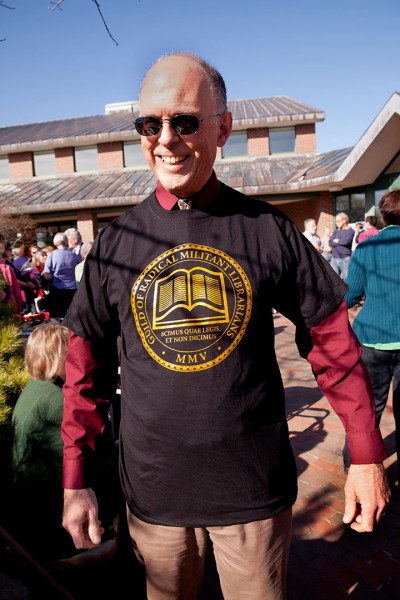
At his retirement reception on April 24, Tom Hayward wears a librarian-themed T-shirt given to him by classics students. The Latin “Scimus quae lemis, et non dicimuc” means “We know what you read and we don’t tell.” (Phyllis Graber Jensen/Bates College)
Throughout his tenure in CMS, Tom has been an active and stalwart colleague. He has supervised numerous student theses and offered numerous independent studies. He has organized meetings of the Maine Classical Conference on campus.
He has taught all levels of Latin and offering courses on a range of topics in translation. He has piloted and pioneered in our curriculum. It was Tom who introduced the idea of tweeting in Latin — mirabile, as they say, dictu.
Tom’s students recall his classes with appreciation and affection. When we posted about Tom’s retirement on the CMS Facebook page, a number of alumni wrote to us.
Annie Barton ’08, now an assistant principal at Strive Prep in West Denver and then a great scholar-athlete at Bates wrote, “I remember Tom cheering me on from the bleachers at my swim meets. It meant so much to me that he cared to support so many different aspects of my life, and that’s what I remember when I think of him.”
Erin Faulder ’08 is now a student in library school (and, oh yes, that trend in classicist librarians that everyone’s talking about: You know whom to thank!).
A wonderful student and a ballroom dance enthusiast, Erin wrote that she remembered most fondly “spending hours at his dining room table with a cup of tea and some cookies while working on thesis and later reciting and translating Seneca’s Troades” and “going to Thorncrag with Tom and his wife one night to listen to the birds singing to each other at dusk. Then, once night had truly fallen, we searched for a certain kind of newt that was just coming out of hibernation.”
Erin Crowley ’12, whose archeological work we’ll all be reading about one day, recalled how Tom offered to meet with her outside of scheduled class time to resolve a scheduling conflict.
“Professor Hayward went above and beyond his duty as a professor to offer me the opportunity to continue with my Latin study, and for that I will be forever grateful. I wasn’t the first student that he had done this for, either, and that shows a dedication to the subject and to his students which made the classical and medieval studies program my absolute favorite.”
Tom embodies Cicero’s observation that a man who has a library and a garden has everything. To Cicero’s library and garden, Tom has added a love of jazz, a talent for watercolors, a delight in birds and a feared ruthlessness on the racquetball courts. He is also a pater familias — the loving husband of Susan, proud father of Abby and Jamie, and, recently, a grandfather.
We are going to miss Tom, and the only balm to our sorrow is the hope that when he’s indulged this foolishness with retirement, had his Italian education, spotted his birds and painted his canvases, he will come to his senses and return to visit.
But for now, we must echo Plautus: Acta est fabula Batesiana; plaudite!
Tribute to Paul Kuritz by Michael Reidy, senior lecturer and managing director of theater and dance
Paul Thomas Kuritz retires from the Department of Theater after 34 years of teaching and scholarship. While completing a Ph.D. from Indiana University in 1978, Paul Kuritz joined the faculty as an assistant professor of theater and rhetoric. He taught acting, directing and theater history as well as directing one or two productions annually. Paul was department chair from 1995 to 2000.
Since his professional debut in 1966, he has directed more than 100 productions across the U.S., serving as guest director at the Maine Acting Company in Lewiston, 1986–88, and founding, in 1980, the Bates Festival Theatre.
The Bates Festival Theater was a professional theater company in residence on the Bates campus that ran for four years in the summer, bringing professional theater to the Lewiston-Auburn audience long before there was a Public Theater in downtown.
In 1992 Paul was chair of the Mayor’s Fine Arts Commission, charged with developing a plan for increasing the cultural production in the area. The ramifications of that work are still felt today, and the topic is still in active debate.
Paul was a visiting professor at Indiana University in 1985 while on leave from Bates.
He was the first American academic to be invited to teach acting and to direct at the National Theater School in Bratislava, Slovakia.
Paul wrote four books on theater while at Bates: Playing: An Introduction to Acting (1982); The Making of Theatre History (1987); Fundamental Acting: A Practical Guide (1997); and The Fiery Serpent: A Christian Theory of Film and Drama (2006).
Gertrude Stein’s Mother of Us All and Doctor Faustus Lights the Lights were described as “irradiant, avant-garde — energetic — spectacular” by colleagues.
Paul’s adaptation of Charlotte Perkins Gilman’s The Yellow Wallpaper was in included in the anthology The Best American Short Plays 2001–2002.
Paul will be well-remembered for several productions he directed for Bates theater over the years. A production of Brecht’s Galileo that he directed and played lead in was remembered for its spectacular, and expensive, staging and for Paul’s passionate performance.
Gertrude Stein’s Mother of Us All and Doctor Faustus Lights the Lights were described as “irradiant, avant-garde — energetic — spectacular” by colleagues.
Paul’s Peer Gynt, a massive play by any standard with 70 roles, was cleverly re-imagined to be performed by a small ensemble of 17 student actors.
He was twice a project scholar for the Portland Stage Company and Maine Humanities Council, in 1984–85 and 1988–89.
In a November 1997 issue of the Lewiston Sun Journal, Paul shared the secret to perfect no-fat Rocky Road brownies: It’s half cup of apple sauce and 2 teaspoons of instant coffee.
As a collaborator, Paul was very generous in his inclusion of the artistic team and bringing order to a range of design and production schemes.
In the last decade, Paul turned his attention to filmmaking. He attended Maine Media Workshop and directed two short films while here, A New Life and Amy’s Wish, which have been selected for screening at multiple film festivals around the country.
Paul will also be know for his propensity to resist popular opinion of the day and claim the ground of the contrarian. Like a salmon swimming upstream, Paul enjoyed challenging people to think differently. Hence, he was a lifelong Yankees fan in the heart of Red Sox Nation. Hence, he arrived in Maine as an outspoken political progressive at a time when Maine was considered a conservative state, and leaves a conservative as our community trends toward being more progressive points of view.
He and his wife, Kathleen, live happily in Lakewood, Ohio.
Tribute to Bonnie Shulman by Meredith Greer, associate professor of mathematics
Bonnie Shulman’s route to Bates was not a typical one. Most of her peers went to college after high school; Bonnie left school.
As Stephanie Higgins ’08 wrote in a student essay about Bonnie that won a national contest, Bonnie felt at that time that math was inaccessible to women and that science was corrupted by the arms race. For several years, Bonnie wrote poetry, lived on a commune and had her daughter. At age 30 she decided to go back to college, then earned a Ph.D. in mathematical physics. She then came to Bates and the mathematics department.
“She surely shook up the department on a number of levels and very beneficially for many students.”
Just three years later, Bonnie won the Kroepsch Award for Excellence in Teaching. One of the students who nominated her, Rachel Hampe ’94, shared some memories of Bonnie with me.
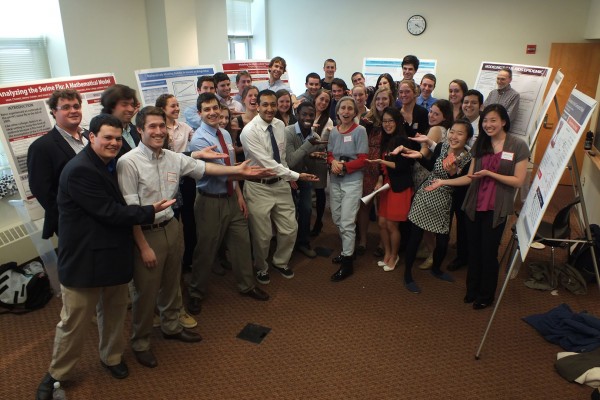
Professor of Mathematics Bonnie Shulman, who retired in June, accepts salutations en masse from math students during the annual Mount David Summit on March 29. (Chip Ross photo)
She recalls that “her arrival in the department was generally very important, but for women who needed a role model to encourage them to continue their studies, it was particularly important. Rarely wearing shoes and almost always carrying coffee into class, she surely shook up the department on a number of levels and very beneficially for many students like myself.”
Rachel went on to say that Bonnie was a “dynamic teacher who appreciated that everyone had different methods of learning. In one class, I remember (now about 20 years ago!) her discussing how some people understood concepts visually, seeing diagrams, while others learned concepts through equations. She deliberately taught the concepts from both perspectives to be inclusive and to deepen our understanding.”
One more quote from Rachel: “I know that after I graduated she incorporated writing and research requirements into her classes. Later, other professors started doing the same.”
Rachel’s quotes show many of the long-term driving forces within Bonnie: helping women break down barriers, supporting all students in learning and valuing writing within mathematics.
During Bonnie’s time at Bates, she has received over a dozen grants in areas including K–12 education and mentoring women in math and science. She chaired Sigma Xi, the scientific research society, from 1993 to 2010. She wrote journal articles that include discussions of feminism as it relates to math and science; reflections on war, peace and mathematics; and mathematics education.
She was very involved with the Program in Women and Gender Studies for several years. And she was one of the leaders of the move toward the current Gen Ed. Our curriculum now has increased opportunity for interdisciplinarity, enhanced writing requirements and emphasis on scientific and quantitative literacy. These were voted in by the faculty as a whole, yet they echo the focus areas Bonnie has always had for educating students.
There are many more things for which Bonnie has made herself known over the years. Here are just a few of them.
She could be defined by her refusal to be constrained. Whenever she, or her whole department, or the entire college, takes on a new goal, Bonnie constantly reminds us to think big: Don’t start out by thinking about restrictions or limitations! Think instead about what we would like to accomplish if we could do anything we wanted. (Then, of course, she is both dogged and ingenious about figuring out how we can accomplish what many would have thought impossible!)
Bonnie is known for bringing students to conferences. And when I say “is known for,” I don’t mean just at Bates. At national conferences, I have several times had someone read “Bates College,” on my name tag and say, “Oh, you must know Bonnie!” One particular mathematician went on in detail, telling me how she had admired Bonnie for many years, especially for the way Bonnie would just load up a vehicle with students and drive them to a regional conference. (I can add to that: Bonnie has a special talent for piecing together funding to support her students and colleagues.)
Social justice has always been a driving force for Bonnie. A culmination of Bonnie’s experiences and talents came with her Math 112 course, “Mathematics for a Just World.” From the course description: “This course teaches quantitative literacy, critical thinking and problem-solving skills in a socially relevant context. Students use mathematics as a powerful analytic framework for understanding and developing realistic solutions to issues of social, political and economic injustice.”
But this is just part of the story. Some students let it be known that they’re taking Math 112 “just to get their [Q] out of the way”; others admit to major math phobia. During the course, students write about math, present math and tutor local children at Tree Street Youth Center. In this class, students keep journals. Many reflect that this is the first time they ever realized that math had a purpose or could be helpful to people. Some, early in the semester, express hesitancy or discomfort about tutoring; some of those same students end the semester saying that tutoring was the most important and powerful thing they did all semester.
Last one — for now. Bonnie is a thoughtful and intentional mentor. She began mentoring me when I interviewed for this job: Though she was on sabbatical at the time, she came to my job talk, introduced herself as the only tenured woman in the mathematics department and warmly invited me to contact her if I had any questions about coming to Bates. When I first arrived here, she purposefully introduced me to many people all around campus. Throughout the years, we have talked about teaching, research, tenure, life and much more.
But enough about me! What about with students, or when Bonnie was new here herself?
One of her first thesis students, Toby White ’94, says that “meeting Bonnie was a watershed moment in my academic career. She took me under her wing, helped me find a path. [She] took me to my first conference (my first three conferences, actually), helped me…write an honors thesis, guided me toward graduate school and a master’s degree…became a collaborator when I returned to Maine to teach high school math, and then again gave critical counsel when several years later I decided to go…for a Ph.D. in education.
“I really can’t imagine how I would have found my way or come nearly so far as a scholar without so much help and support from her at the start, and along the way. She remains a dear friend, a model for the ways I advise my doctoral students, and my fiercest, most regular and favorite mobile Scrabble opponent.”
There is much, much more that I and others could say about Bonnie — her sense of humor, her athleticism, her activism — but for now I end simply. Congratulations, Bonnie. You are tremendously appreciated.
Tribute to Bob Thomas by Sharon Kinsman, associate professor of biology
Professor Robert Thomas — sage of seaweeds and lover of liverworts — is the consummate botanist. But he almost wasn’t.
He headed to the University of Michigan to become a history teacher but discovered a greater passion when he chose introductory botany for his science requirement. And the rest, as Bob might pun, is his-tory. Soon he TA’d the course, took field courses, joined the professor’s lab and co-authored two papers with her.
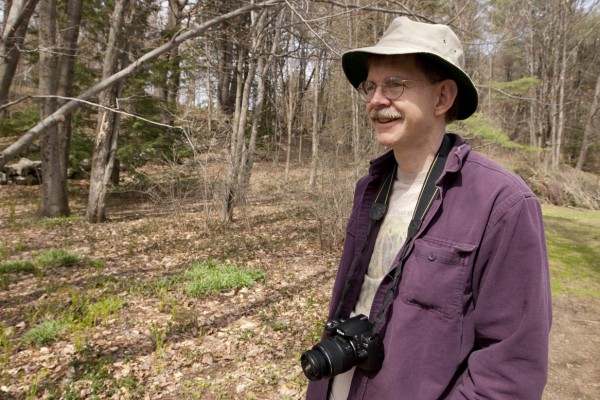
Professor of Biology Robert Thomas, photographed at the McLaughlin Garden in South Paris, Maine, while teaching his Short Term course on nature photography in 2008. (Phyllis Graber Jensen/Bates College)
Straight on to graduate study at the University of California–Santa Cruz (a far cry from the North Woods of Michigan), Bob studied with world-famous bryologists and plant physiologists. He mastered several modern research techniques to study liverwort development and physiology.
Bates snapped him up even before his defense.
So in 1975 Bob returned to the North Woods, bringing a deep knowledge of plants; a passion for teaching; modern expertise in tissue culture, autoradiographic techniques and electron microscopy; and a determination to help the department steadily acquire modern research equipment.
Bob said “Yes!” to students with diverse interests, from natural plant dyes to lichens as environmental teaching tools to soil quality in urban agriculture.
Mosses and their relatives were model organisms for a multitude of research questions. External grants helped support Bob’s and his students’ year round research on plant development, hormones, and physiology. By the time Bob was promoted to full professor a little over a decade after his arrival, student co-authors featured on nearly all of his many Bates research publications. But you didn’t have to study mosses or their tiny aphids to do research with Bob. Bob said “Yes!” to students with diverse interests, from natural plant dyes to lichens as environmental teaching tools to soil quality in urban agriculture.
And it was an adventure-filled lab to join. Summers began with the annual jaunt down Sabattus Street for opening day at Val’s Drive-In and root beer stand. Field trips took the gang to nearby forests, mountains and bogs. But it was the cross-country camping trips to attend professional meetings that his students likely won’t forget. Funds were few, but that didn’t stop Bob. He just loaded up the infamous Morse Mountain van with students and Outing Club gear, and drove long distances — to Montreal, to Virginia and once all the way across the continent to Vancouver — camping all the way.
Bob’s courses offered adventures as well. His expertise led to an array of engaging traditional and applied courses, from microbiology and numerous plant biology topics to electron microscopy, to this year’s first-year seminar on GMOs.
Legendary were course field trips: to find seaweeds at the coast, to sample phytoplankton in the open ocean, to press flowering plants, to work with foresters and horticulturalists and florists, and to talk with algologists, ethnobotanists, organic gardeners and plant chemists. Graduation weekends saw packed audiences for the breathtaking slide shows from his popular Short Term course in nature photography.
And yes, Bob co-taught a course in ballroom dancing.
But I think in Carnegie we would agree it was the famous economic botany course that will live on in memory. Certainly it engaged non-science majors, but it made Carnegie lively for all of us. From the paper-making lab with its odd smells and strewn plant debris to the “seed-popping” lab that destroyed more hot plates than we can remember, we saw hands-on education at work. New faculty, not yet in the know, might get a whiff of fermentation but be a little reluctant to ask…just what was fermenting?! Yes, root beer and even real beer, complete with “little accidents” of corks popping…and the occasional muffled explosion as beer bottles burst.
The Carnegie basement brewery is gone, and other changes have come. When Bob arrived, most department chairs were “forever.” Departments used one phone line for everyone, mimeograph machines for handouts and typewriters for writing. Ladd Library was brand new, and Carnegie Science was about half its current size. The number of women faculty could be counted on two hands. Tenure procedures were, well, more relaxed. In fact, it was Bob who asked senior colleagues if he should provide some names of outside evaluators. They responded: “OK, why not?”
In the department, Bob has seen whole new subdisciplines of biology arrive, along with more student majors and more assistants in instruction. Six classical majors’ core courses have become three, electives have multiplied and our crowded “old Carnegie” is now an equally crowded “new Carnegie.”
Much of the department’s development was facilitated by Bob. Upon tenure, Bob agreed to a “temporary” two-year stint as chair. The two years became 10, as Bob oversaw new faculty lines, a core curriculum revision, a building addition and the installation of the first of two electron microscopes. Bob then continued to support the work of the department in ways too numerous to name. Early work for the college included six years on the Student Conduct Committee, an insightful report on athletics, and work on long-range planning and development of audio visual support. Service on many college committees followed.
But many of us know Bob best as our own colleague and friend. From procuring our research equipment through national grants, to supportive listening to junior colleagues’ concerns, to adding a voice of experience to countless searches, to modeling patience and compromise in departmental matters, to advising on grant proposals and tenure dossiers, Bob has made an enormous positive difference for many new colleagues. Arriving at Bates, we immediately find in Bob a modest, moderate, mild-mannered, and mannerly colleague who is reliable, kind and supportive. At length we are blessed to discover that wry, dry sense of humor complete with dead-pan delivery.
And many Bates students have known Bob best as their Bates Outing Club adviser. Firmly committed to student leadership of the club, Bob provided steady support over decades and over maintenance of 40 miles of the Appalachian Trail. A colleague recalls how the “Outing Clubbers of the late ’70s warmly remember evenings at Bob’s house on Nichols Street, the livingroom ringing with folk songs, the floors pounding with dance steps.”
These evenings of potluck dinners, music, laughter and dance were long a part of the heart of southern Maine’s traditional music and dance scene. A wonderful musician and dancer, Bob sings and plays mountain dulcimer and concertina and helped found the Bates Free Will Folk Society.
Bob’s music now graces community events, often as part of his devoted family life. With two sons now in their teens, Bob and Carol generously offer their skills and support to a variety of local educational and non-profit institutions, including Sandcastle Clinical & Educational Services, with its focus on inclusive education, and St. Joseph’s Special Religious Education.
In thanks to Bob, a few student voices:
“A very big thank you is due to my adviser, Bob Thomas, for all of his patience, encouragement, guidance, and generosity over the last three years.He continually challenged me and advised me in such a way that made research and the thesis experience lots of fun.”
“The lectures were pure gold!”
“A very fun and interesting course.”
“I felt very included and the professor was very kind and respectful.”
“…a great FYS professor…I had a really good time in the class.”
The department won’t be the same without the nature photography shows; Bob’s supportive, moderate, and kind demeanor; and his well-timed puns and amazing recall of departmental history. As one colleague notes: “Woe unto us when he’s gone on that front.” But he’s not going far: just over to Taylor Pond. So, Bob, if someone asks, “Would you Lycopodium?” it’s OK to decline, but we will miss you.
With thanks to Bob for providing materials, and to Greg Anderson, Judy Marden ’66, and Nancy Kleckner for contributions.
